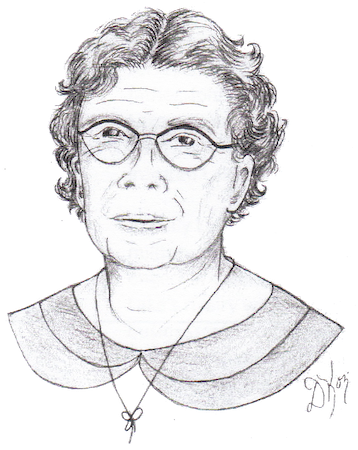A half century of teaching
Fannie Elizabeth Beach impacted Woodmont in a special way because she taught school there for fifty years, retiring in 1934. At first, all eight grades were in a one-room schoolhouse, later six grades, and later still the upper grades in a two-room brick school (built in 1917) of which she was also the principal. The family always said, "Aunt Fannie taught for fifty years." In fact, it as important to her to each that last year to make it 50. But the town records do not list her as teacher until 1891, which would make it 43 years. It is possible that Fannie, who graduated from Milford High School in 1883, began teaching that same fall. That was not uncommon back then, especially in country schools. It may have then taken her seven years to earn her certification explaining the delay in having her name appearing on the teachers' list for the town.
She did not go away to college, but did take teaching courses, always read widely, and, of course, would have accepted advice from more experienced teachers. She not only taught "reading, writing, an 'rithmatic," but on some Saturdays took the school children on nature walks through woods and fields, and taught the names of trees, wild flowers and birds. Her niece, Ruth Beach (Sykes), always very good at identifying wildlife, said she had learned most of that from "Aunt Fannie."
Fannie was always interested in the way the lives of her former pupils developed. Some of them came back to see her, and kept in touch over the years. One of them, Granville P. Lindley, was a member of the Byrd Antarctic Expedition II. He wrote two letters to her while on the expedition (in 1933 and 1934), that she kept all her life.
When Fannie was born, a couple of years after the conclusion of the Civil War, Woodmont was a sparsely populated rural farmland and woods. In the early 1870s a few people began to build summer cottages on the shore of Long Island Sound, about a mile from the Beach farm. In 1898 a trolley line going right through was built between New Haven and Milford Center and on to Bridgeport. By 1906 with this "easy access," the summer population of Woodmont 'exploded' to about 2000. Many cottages and hotels were built near the water to accommodate the seasonal influx. After Labor Day, the "summer people" went back to their homes elsewhere, and Woodmont was returned to its relatively few permanent inhabitants who lived mostly farmed and operated a few small businesses.
After Fannie's parents died - in 1911 and 1914 respectively, she continued to live on in her apartment on the second floor of the Beach family farmhouse. The large house was built by Fannie's father, Theodore Elliott Beach, sometime in the 1880s or '90s. The records that would have shown the precise year were destroyed by fire when the Town Hall burned in 1915. It had 17 rooms on three floors and stood on the same spot where the "old house" had stood
According to the Commemorative Biographical Record of New Haven County, Connecticut, (1902): Theodore Elliott Beach has always resided at his present homestead, and since taking charge of the place has made a specialty of seed growing. The place contains fifty acres (later it increased to 150 acres), with new buildings and modern improvements, and his new residence is one of the best in the vicinity of Woodmont.
Fannie's brother, Frank J. Beach, who always worked with his father on the farm and, owned and operated the farm after the older man died in 1911. Fannie boarded with hm and his family in the homestead. Frank had married Eda Maude Rhodes in 1898, and they raised their family there. Fannie taught their children in school (the Beach children called her "Aunt Fannie" at home and "Miss Beach" at school). Frank and Eda had one boy - Ralph - five girls - Emily, Ada, Ruth, Ethel and Edith. Ruth always thought "Aunt Fannie" was a wonderful aunt, an excellent teacher, and an outstanding person. When Frank died in 1932 his son, Ralph continued to work the farm as owner and operator.
The whole family was very active in the Mary Taylor Memorial Methodist Church in Milford. That church had been born in a Christian Revival in Milford in 1836. Fannie's mother's parents, Elizabeth Ann Platt and Eliakim Fenn, were one of the founding families of the Methodist Church in Milford.
Fannie lived frugally, but was generous to others. This Author's mother Ruth (Fannie's Niece) told me that when she went to Virginia to do Christian mission work, Aunt Fannie gave her $25.00 to put into the bank (a generous sum back then); so "you will always be able to come home." Aunt Fannie also paid for the material for Mother's wedding dress.
When Aunt Fannie knew that I would like to have a china clock that had been a wedding gift to my Beach grandparents, she had it repaired for me. I have a letter from her about this written in 1958.
Since none of the women in the Beach family at that time drove automobiles, Fannie most often walked to school, went by trolley, occasionally Ralph would take her by car, to New Haven and Milford, less regularly she visited Bridgeport - getting there the same way. Frequently she and her sister, Ida (who lived with her during their retired years) took in a movie in one of the cities. When they went to New Haven, normally once a week, they visited their bank and did some shopping. Fannie and Ida, her sister and companion, traveled by ship to Europe in the summers of 1924 and 1928 visiting France, Italy, Switzerland, Belgium, England, and Scotland.
When we were children, my cousin, Peggy Beach, and I loved to play table games with Aunt Fannie. She taught us to play Chinese checkers, dominoes, checkers and Parcheesi. She delighted in children, and we sensed that.
Aunt Fannie was nearly 89 when Ida died at almost 87 in January 1956. After an initial depression, Aunt Fannie told me that their minister helped her overcome it. She decided to take Spanish (or it might have been French) lessons she thought it would be good for her mind. She was quite a lady!
I do not remember hearing anyone in the family say anything negative of Aunt Fannie - and she lived there in the same house with them and ate her meals with them. She was a very loving, easy-to-live-with person. She was kind, thoughtful of others, "sweet," nurturing, a "peace-maker" and "motherly." The family all loved, admired and respected her.
Aunt Fannie was always provided with a tea pot of hot water and a cup and saucer with her meals. She never, or rarely, drank tea or coffee - only hot water. I know this was not for religious reasons. Maybe it was simply what she liked it, or might have thought it was a healthy thing to do. I have recently learned that many people back then thought drinking hot water was good for the bowels. Perhaps it was. She died three months short of her one hundredth birthday.
The last couple of years of her life, Fannie suffered from dementia and was confined to a nursing home in Milford. In 1966 the Milford school board decided to honor the memory of Annie E. Beach by renaming the Woodmont Elementary School, the Fannie E. Beach School. Although she did not live quite long enough to be present for this event in 1970, she knew it was "in the works" which pleased her.



